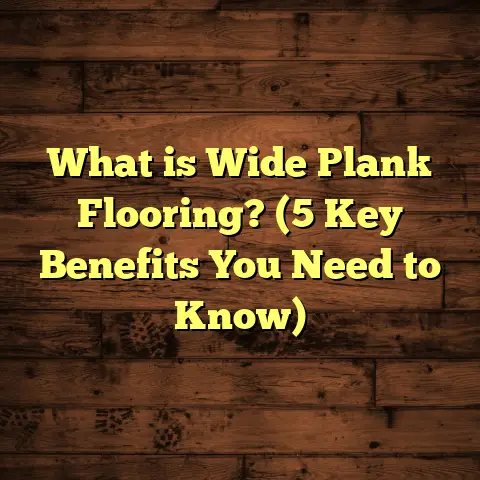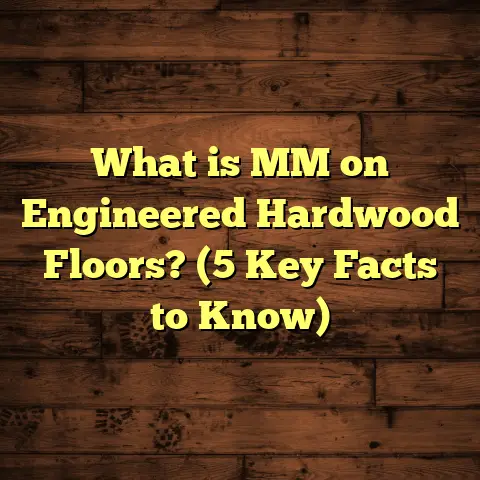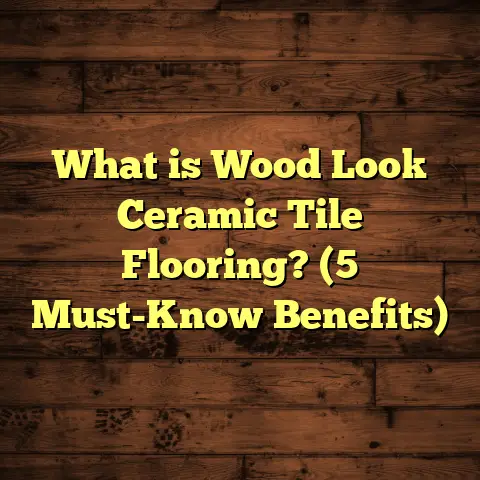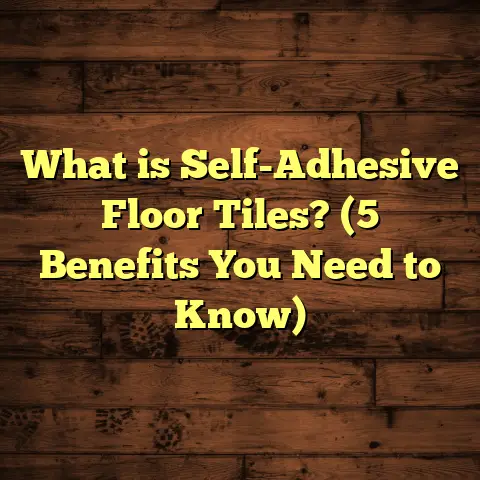What is a Floor Board? (5 Essential Types You Must Know!)
When I think about flooring, the first thing that comes to mind is how the room’s function shapes what flooring material works best. You wouldn’t want the same type of floor in a bathroom as you would in a bedroom, right? Each room has its own demands—whether it’s moisture resistance in the kitchen, warmth in the living room, or durability in a high-traffic hallway. Over the years working with countless clients and projects, I’ve learned that understanding floor boards—the very building blocks of your floor—is key to picking the right material and ensuring long-lasting satisfaction.
What Is a Floor Board?
At its simplest, a floor board is a flat piece of material used to cover floors. But that plain definition barely scratches the surface. Floor boards are designed to fit together to create a stable, attractive, and functional surface. They can be made from solid wood, engineered layers of wood, synthetic materials, or natural alternatives like bamboo.
Floor boards vary widely in thickness, width, length, texture, and durability, depending on their intended use. The composition of a floor board affects everything: from how it handles moisture and foot traffic to how it looks and feels underfoot.
When I first started in flooring, I thought all floor boards were pretty much the same—a simple wood plank nailed down. But it didn’t take long before I realized that the differences between solid hardwood and engineered wood, or laminate and vinyl, are huge. Each type has its own chemistry, installation techniques, lifespan, and maintenance needs. Knowing these differences upfront can save you time, money, and headaches.
Why Does Room-Specific Flooring Matter?
Before choosing a floor board, I ask myself: What kind of room is this? What’s the expected foot traffic? Will there be moisture or spills? Will kids or pets be around? What’s the desired look and feel?
For example:
- Kitchens need floors that resist water and stains.
- Bathrooms require materials that won’t warp or grow mold.
- Living rooms often call for warm, inviting textures.
- Basements need moisture-resistant options because of potential dampness.
Your choice of floor board can make or break the room’s functionality and aesthetics.
The Five Essential Types of Floor Boards
Over my years in the flooring industry, I’ve worked extensively with five main types of floor boards. Each has its pros and cons depending on your needs. Let’s explore them one by one.
1. Solid Hardwood Floor Boards
You can’t talk flooring without mentioning solid hardwood. This is the classic choice—boards made from a single piece of timber milled from hardwood trees like oak, maple, hickory, or walnut.
What Makes Solid Hardwood Special?
Because it’s 100% natural wood throughout the plank, solid hardwood is incredibly durable and can be sanded and refinished numerous times. This means if your floor gets scratched or dull over time, you can restore it to near-new condition by sanding off the top layer.
From my personal experience installing solid hardwood in my own home’s dining room, I can attest to its beauty and longevity. The natural grain patterns and warmth of wood add character you just don’t get with synthetic floors.
Durability & Lifespan
According to the National Wood Flooring Association (NWFA), properly maintained solid hardwood floors can last more than 100 years. That’s why many historic homes still have original hardwood flooring.
Typical thickness ranges from 3/4 inch (about 19 mm), giving the planks excellent stability and resistance to warping. However, because wood is porous and reacts to moisture changes by expanding or contracting, solid hardwood doesn’t perform well in high humidity or wet areas like bathrooms or basements.
Installation Techniques
Solid hardwood is traditionally nailed or stapled down to wood subfloors. It requires precise acclimation beforehand—meaning you have to let the wood adjust to your home’s humidity and temperature for days or weeks before installation to reduce movement post-installation.
Cost Considerations
On average, solid hardwood flooring costs between $6 to $12 per square foot for materials alone. Installation can add another $3 to $8 per square foot depending on complexity and location.
I once installed solid hardwood in a 1,000-square-foot home office—it was an investment but worth every penny for the timeless look and feel it brought.
2. Engineered Wood Floor Boards
Engineered wood offers a clever alternative to solid hardwood by combining thin layers of real wood with plywood or fiberboard underneath. This layered construction gives engineered wood better dimensional stability.
How Engineered Wood Works
From my experience installing engineered wood in humid coastal homes, it performs far better than solid hardwood where moisture is unavoidable. One client near the ocean was thrilled that their floors didn’t warp or swell after heavy storms.
Benefits & Drawbacks
- Benefits: Moisture resistance, ease of installation (can be nailed, glued down, or floated), lower cost than solid hardwood.
- Drawbacks: Limited refinishing potential since the top veneer is thin; cheaper versions may have lower-quality veneers prone to damage.
Costs & Lifespan
Engineered wood flooring typically costs 20-30% less than solid hardwood—around $4 to $8 per square foot for materials. Installation costs are often similar or slightly lower since floating installations are popular.
Lifespan varies but generally ranges from 20 to 30 years with good care. Some high-end engineered floors can last longer depending on veneer thickness.
3. Laminate Floor Boards
Laminate has come a long way since its early days as “fake wood.” It’s now a popular budget-friendly option that mimics natural materials well without breaking the bank.
What Is Laminate Flooring Made Of?
Laminate floor boards consist of several layers:
- A high-density fiberboard (HDF) core for strength.
- A photographic layer that replicates wood grain or stone patterns.
- A clear wear layer protecting against scratches and stains.
When installing laminate, you typically use a floating method where boards snap together without glue or nails. This makes it a favorite among DIYers.
My Experience With Laminate
I’ve laid laminate floors in rental properties where tenants needed affordable yet durable surfaces. It stands up well to scratches from pets and kids but doesn’t handle moisture well—spills need quick clean-up to avoid swelling at the seams.
Cost & Popularity
Laminate costs range from $1 to $5 per square foot for materials—one of the most affordable options out there. Installation is usually $2-$5 per square foot if hiring pros.
According to industry reports, laminate flooring sales have steadily grown due to improved designs and affordability.
4. Vinyl Floor Boards (Luxury Vinyl Planks)
Vinyl flooring has seen a huge surge thanks to luxury vinyl planks (LVP), which combine durability with realistic aesthetics.
Why Vinyl Is So Popular Now
LVP features multiple layers: a waterproof core topped with detailed photographic layers sealed by wear-resistant coatings. This means you get floors that look like real wood or stone but stand up superbly against water damage.
I installed LVP in a busy kitchen where kids frequently spilled drinks and dropped utensils. Years later, the floor looked as good as day one — no swelling or cracking.
Cost & Durability
Vinyl flooring accounts for about 30% of residential flooring sales in North America today. Thickness varies from 2 mm up to 8 mm or more in premium products.
Prices generally range from $2 to $7 per square foot for materials; installation costs are usually low since LVP can often be floated over existing floors.
5. Bamboo Floor Boards
Bamboo might surprise some as it isn’t technically wood—it’s grass! But it behaves like hardwood when processed into floor boards.
Bamboo’s Eco-Friendly Appeal
Because bamboo grows much faster than traditional hardwood trees (some species mature in just 5 years), it’s considered an eco-friendly alternative for those concerned about sustainability.
I installed bamboo floors for an eco-conscious client who loved the unique grain patterns and hardness comparable to oak. It added a modern yet natural vibe to their living space.
Performance & Cost
Bamboo flooring hardness often surpasses traditional hardwoods like oak or maple but remains sensitive to moisture fluctuations if not properly sealed.
Price-wise, bamboo runs around $2-$8 per square foot depending on quality and strand weaving technique used.
How These Floor Boards Stack Up: A Comparative Analysis
Let me break down some key factors across these five types so you can see how they compare side-by-side:
| Feature | Solid Hardwood | Engineered Wood | Laminate | Luxury Vinyl Plank | Bamboo |
|---|---|---|---|---|---|
| Cost Per Sq Ft | $6-$12 | $4-$8 | $1-$5 | $2-$7 | $2-$8 |
| Durability | Very High | High | Moderate | Very High | High |
| Water Resistance | Low | Moderate | Low | Excellent | Low |
| Refinishing Ability | Multiple Times | Limited (once/twice) | None | None | Limited |
| Installation | Professional | Professional/DIY | DIY Friendly | DIY Friendly | Professional |
| Eco-Friendly | Depends on source | Depends on source | Not Eco-Friendly | Not Eco-Friendly | Very Eco-Friendly |
Real-World Case Studies & Insights
Case Study 1: Renovating a High-Moisture Basement
I once faced a project in a basement prone to humidity fluctuations. The client wanted something warm but resistant to moisture. We ruled out solid hardwood immediately due to rot concerns.
Instead, we chose engineered wood with a high-quality plywood base paired with a vapor barrier underneath. After three years, the floor held up perfectly — no cupping or mold growth. This experience confirmed my belief that matching floor board type to environment saves long-term headaches.
Case Study 2: Budget-Friendly Rental Unit Flooring
For landlords managing rental properties with frequent tenant turnover, laminate flooring often wins out due to affordability and scratch resistance.
In one project covering 1,200 sq ft across multiple units, laminate installation kept costs under budget while providing durable surfaces that stood up well against heavy foot traffic and pets.
Personal Experience: Using FloorTally for Cost Planning
One challenge I frequently encounter is accurately calculating material needs and installation costs for each project. Estimating waste percentages—usually between 5% to 10% extra materials—is critical but easy to overlook manually.
That’s where tools like FloorTally come into play for me. By entering room dimensions and selecting specific materials with local labor rates included automatically, it quickly generates realistic budget estimates. This saves time and reduces errors compared to juggling spreadsheets or multiple quotes from suppliers.
Some Interesting Data Points From The Flooring Industry
- According to recent market research reports, global engineered wood flooring sales are projected to grow at about 6% CAGR over the next five years due to urbanization and rising demand for moisture-resistant options.
- Vinyl’s share of residential flooring increased by nearly 15% over the past decade as homeowners seek waterproof yet stylish floors.
- Laminate remains popular in mid-range housing markets thanks to cost-efficiency but faces competition from improved vinyl products.
- Solid hardwood prices have risen approximately 20% over five years due to supply chain constraints affecting lumber availability worldwide.
- Bamboo’s eco-friendly reputation continues boosting demand among environmentally conscious consumers despite its sensitivity issues indoors without proper sealing.
Final Thoughts on Choosing Your Floor Board
If you’re weighing your options for new flooring or a renovation, here are some questions I’d ask myself:
- Which room am I installing in?
- How much traffic will this floor see?
- Is moisture going to be an issue?
- What’s my budget?
- How much maintenance am I willing to do?
- Do I want something eco-friendly?
Answering these will help narrow down your choices:
- For longevity and classic appeal: go solid hardwood.
- For moisture-prone areas: engineered wood or luxury vinyl plank.
- For budget-friendly DIY installs: laminate or vinyl.
- For sustainability: bamboo (with proper care).
From my perspective as someone who’s installed all these types multiple times over many years, there’s no one-size-fits-all answer. But understanding these floor boards deeply helps you make decisions that last decades rather than months.
Got questions about your specific project? Feel free to ask—I’m always happy to share what I’ve learned firsthand!
This detailed guide covers everything you need about floor boards—from practical room considerations through detailed comparisons backed by real-world experience and industry data. Flooring choices shape how your home feels every day; picking wisely makes all the difference.





